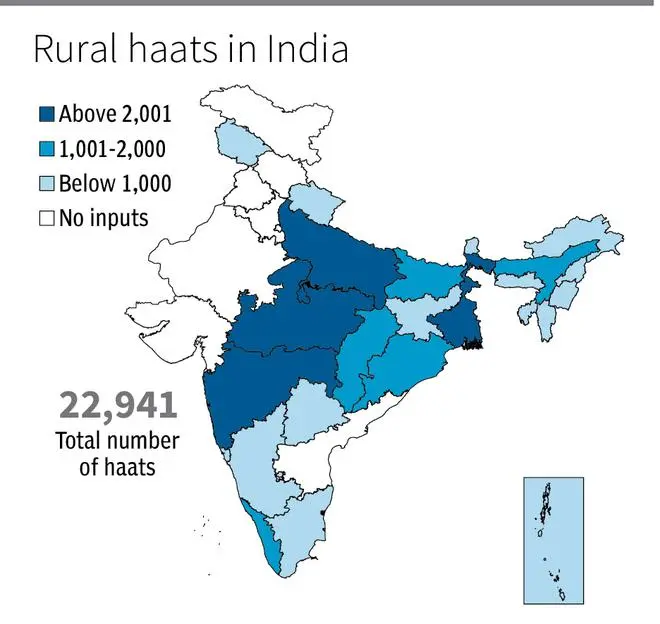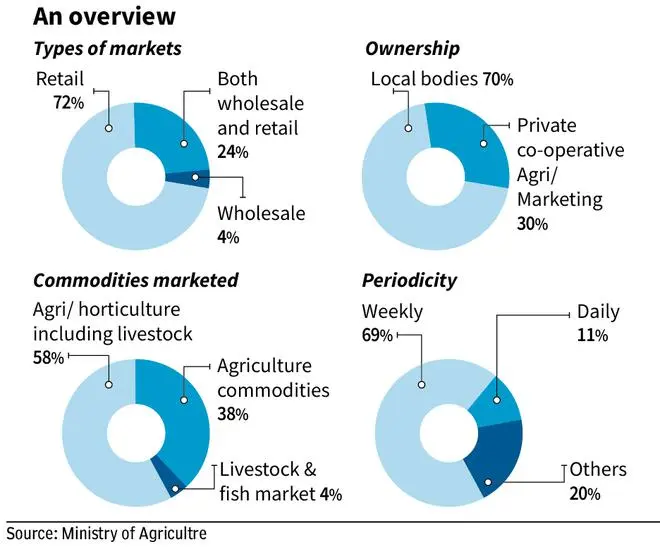Out of crops sold by agricultural households under major disposal agencies (in quantity), over 93 per cent jowar, 90 per cent maize, 82 per cent potato, 88 per cent of onion and 62 per cent of paddy were sold in local markets, according to the Situation Assessment of Agricultural Households and Land and Holdings of Households in Rural India (2019) report.
The data highlights the importance of local markets in agri-trading and the urgency with which the government needs to push for the scheme to upgrade local markets.
In the 2018-19 Budget, the Centre had announced to develop and upgrade existing 22,000 rural haats into gramin agricultural markets (GrAMs) and strengthen physical infrastructure using MGNREGS and other government schemes. The data available with the government (as of April 2022) show that physical infrastructure/facilities under MGNREGS have been developed in 1,351 village haats while work is in progress in another 1,632.

Farmers from nearby villages bring the agricultural produce at harvest time to the local markets or mandis in small towns and cities where traders buy this produce from them. Local private trader refers to the private traders or households to which an agricultural household is selling off their produce.
Commodities traded
Compared to the Agricultural Produce Market Committees (APMC), farmers prefer these local markets, show the data. The assessment survey shows that only 3 per cent jowar (in quantity) and maize, 7.5 per cent of potatoes, 5.2 per cent of onions and 2.7 per cent of paddy were disposed of in APMCs (January-June 2019).
The survey of 9,477 haats conducted by the government shows that 72 per cent of them are retail markets while 24 per cent are retail and wholesale markets and 70 per cent are run by local governing bodies. However, local governing bodies lack funds to develop infrastructure for these markets. The majority of these markets (69 per cent) are operated weekly while only 11 per cent are operated daily.
Interestingly, these markets are dominated by agri/horticulture, including livestock, commodities (58 per cent) and 38 per cent of agriculture commodities.

PPP model
The Ministry of Agriculture has formulated operational guidelines for local markets to ensure efficient management and operation of GrAMs. The guidelines envisage that States shall provide a level playing field to all categories of markets — public sector, private sector, public-private partnership (PPP), etc.
After the development and upgradation of rural haats into GrAMs, these will be electronically linked to e-NAM platform to facilitate farmers to make direct transactions with consumers and bulk purchasers. Nashik-based Sahyadri Farm (FPC) MD Vilas Shinde said farmers must have all options open to trade their produce and the emergence of private markets and strengthening of local markets will create stiff competition to APMCs.




Comments
Comments have to be in English, and in full sentences. They cannot be abusive or personal. Please abide by our community guidelines for posting your comments.
We have migrated to a new commenting platform. If you are already a registered user of TheHindu Businessline and logged in, you may continue to engage with our articles. If you do not have an account please register and login to post comments. Users can access their older comments by logging into their accounts on Vuukle.